This easy homemade parmesan broth recipe is our favorite way to repurpose leftover parmesan cheese rinds! It's a perfect complement to pasta, soups, and more. Ready in just a few hours and freezer friendly!
If you're ready to take your home cooking to the next level, look no further than a pot of cozy homemade parmesan broth.
This magical elixir lends a complex - but delicate - umami flavor to pastas, soups, stews, and beyond (it's especially excellent with our brothy weeknight butter beans). Use it anywhere you'd use chicken stock or vegetable broth for a tasty, restaurant-quality twist!
Jump to:
Ingredients
Parmesan broth is simple and very forgiving: It's the kind of thing that you can make a little bit differently every time. That said, we find it's useful to start with a solid base recipe and a few key ingredients.
The MVP: Parmesan Rinds

Parmesan rinds are the hard outer edges of a wheel of Parmigiano Reggiano cheese. These tough edges develop as the parmesan ages, and protect the softer cheese inside. Because parmesan rinds are so dense and dry, they're not really edible, so they're typically discarded once the cheese itself is eaten.
But despite their unappealing texture, parmesan rinds still pack a ton of flavor, making them the perfect base for our parmesan rind stock!
Where to Find Parmesan Rinds
When you buy a block of Parmigiano Reggiano cheese, look for a wedge that still has the rind attached. Slice, shred, and enjoy the cheese normally. When the parmesan itself is gone, hang onto the leftover rind!
Store parmesan rinds in an airtight container (we love using a Stasher Bag) in the freezer. Once you've collected a handful, make a batch of this broth.
Some grocery stores also sell parmesan rinds on their own: Ask at your cheese counter if you'd like to buy enough ready-to-go rinds to make stock!
Pro Tip: Look for true Parmigiano Reggiano cheese rinds for best results. In the U.S., many cheeses are simply labeled "parmesan", but these inauthentic parmesans can melt strangely and even impart a bitter, unappetizing taste. Real parmesan cheese will be labeled "Parmigiano Reggiano", and will also have those words stamped along the rind in large letters made of small dots. Learn more: How to tell if your Parmigiano Reggiano is the real thing.
Flavor enhancers
While the parmesan rinds are the star of the show, it takes a village to bring this broth together. Here's a snapshot of what you'll need (for a full ingredient list and exact measurements, scroll to the recipe card below):

Before you jump in, we want to highlight a few things:
- Kosher salt ensures our broth is seasoned properly, while whole black peppercorns lend a bit of depth.
- Red pepper flakes are one of our favorite additions to parmesan stock. Just a pinch will lend a barely-there spice that makes the broth sparkle.
- White wine adds dimension and makes the flavor a little more complex.
- A Shallot brings balance to this broth, its reddish hue also gives our broth a richer, more vibrant color.
- Garlic and celery give us deep, umami flavor with just a subtle hint of garlic.
Note: There's plenty of flavor to be extracted from the papery skins of shallots, onions, and garlic! Peel off the very outermost layer of the skin (especially if it's dirty!) but leave the rest of the skins intact when you make any broth or stock.
Variations and Substitutions
Good parmesan rinds, a pinch of kosher salt, and plenty of water are non-negotiable here (they're the building blocks of the entire broth!) But you have a ton of flexibility when it comes to the supporting flavors. We call these extras our "flavor enhancers".
We recommend using 4-6 flavor enhancers any time you make parmesan stock. We've included six of our favorite additions in this recipe (white wine, shallot, garlic, celery, black peppercorns, and red pepper flakes), but this broth also works well with:
- Carrots
- Onions
- Herbs (bay leaves, parsley stems, thyme sprigs, etc.)
- Mushrooms
- Leeks (This is a perfect place to use any tough, dark leek greens left over from our Leek Breakfast Hash, Potato Leek Soup, or Leek Frittata!)
- For more umami: Add mushrooms, extra celery, carrots, or seaweed flakes.
- For more spice: Add extra red pepper flakes, or stir in a few jalapeño or poblano pepper slices.
Pro Tip: You don't need to use perfect, whole ingredients in this stock. When you have extra trimmings from chopping a shallot or onion, prepping some veggies, or roasting garlic, throw them in an airtight container and keep them in the freezer. When you're ready to make broth, throw those veggie scraps in along with the parmesan rinds!
Step by Step Instructions
Sauté the Veggies
Heat a bit of olive oil in a large stock pot over medium-high heat, then add your veggies (Image 1, below) and cook for a few minutes until they begin to brown (Image 2).

Try to get a good, dark sear on the surface of these ingredients: Browning the veggies develops a ton of flavor and makes our stock richer and more interesting.
Tip: If you're short on time, you can skip this step! You'll lose a little bit of the depth of flavor you get from browning everything up, but the stock will still taste great.
Add Liquid
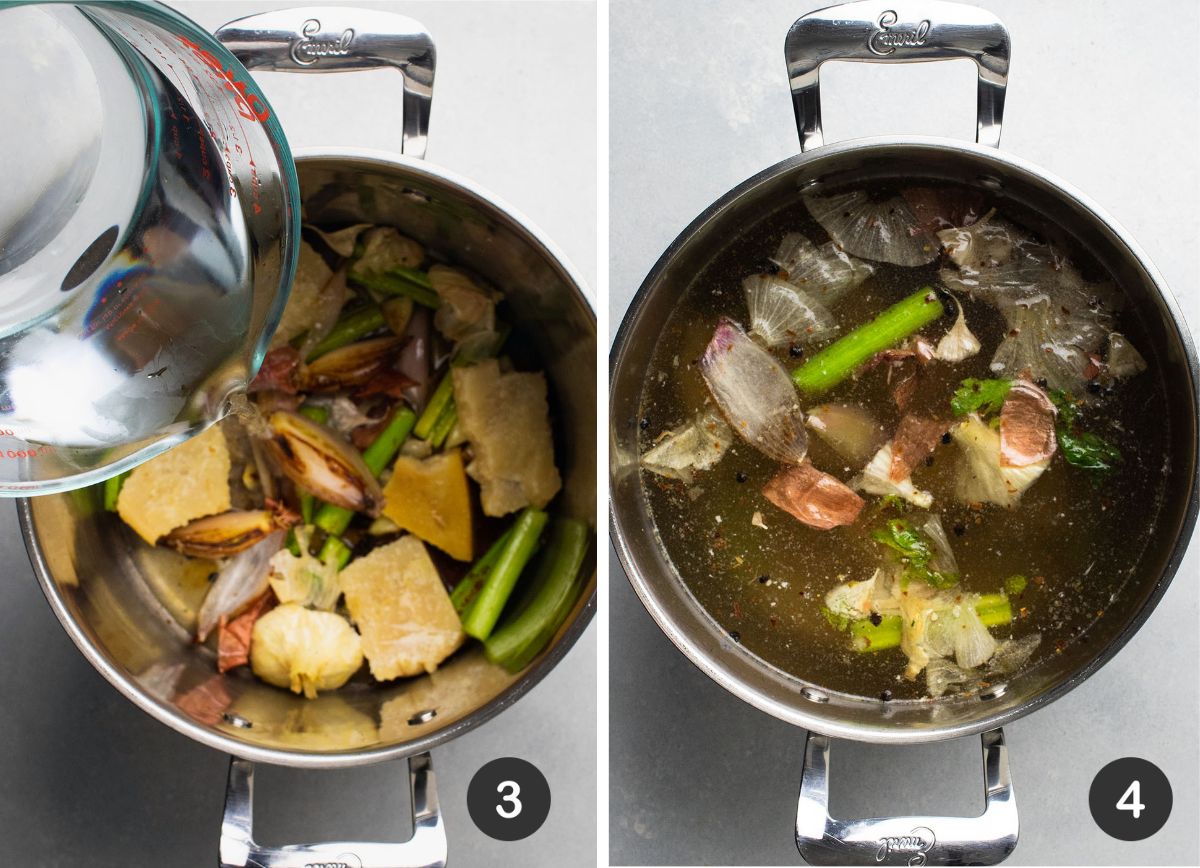
When you have a nice sear on the veggies, deglaze the pan with some white wine. Be sure to scrape up any browned bits at the bottom of the pan - that's where a ton of flavor lives!
Add the parmesan rinds and any extra flavor enhancers (like peppercorns or red pepper flakes), then fill the pot with water (Image 3, above), add a pinch of kosher salt, and stir everything together (Image 4).
Let it Simmer

Bring the broth to a low simmer and cook for 2-4 hours, until the veggies are soft and have lost most of their color (Image 5, above).
Pro Tip: Because there's still a bit of cheese on the parmesan rinds, they like to stick to the bottom of the pot. Stir the broth every hour or so as it cooks to loosen them up!
Strain the Broth
Let your stock cool for 30 minutes to an hour on the stovetop to make it easier to handle. Then, it's time to strain!
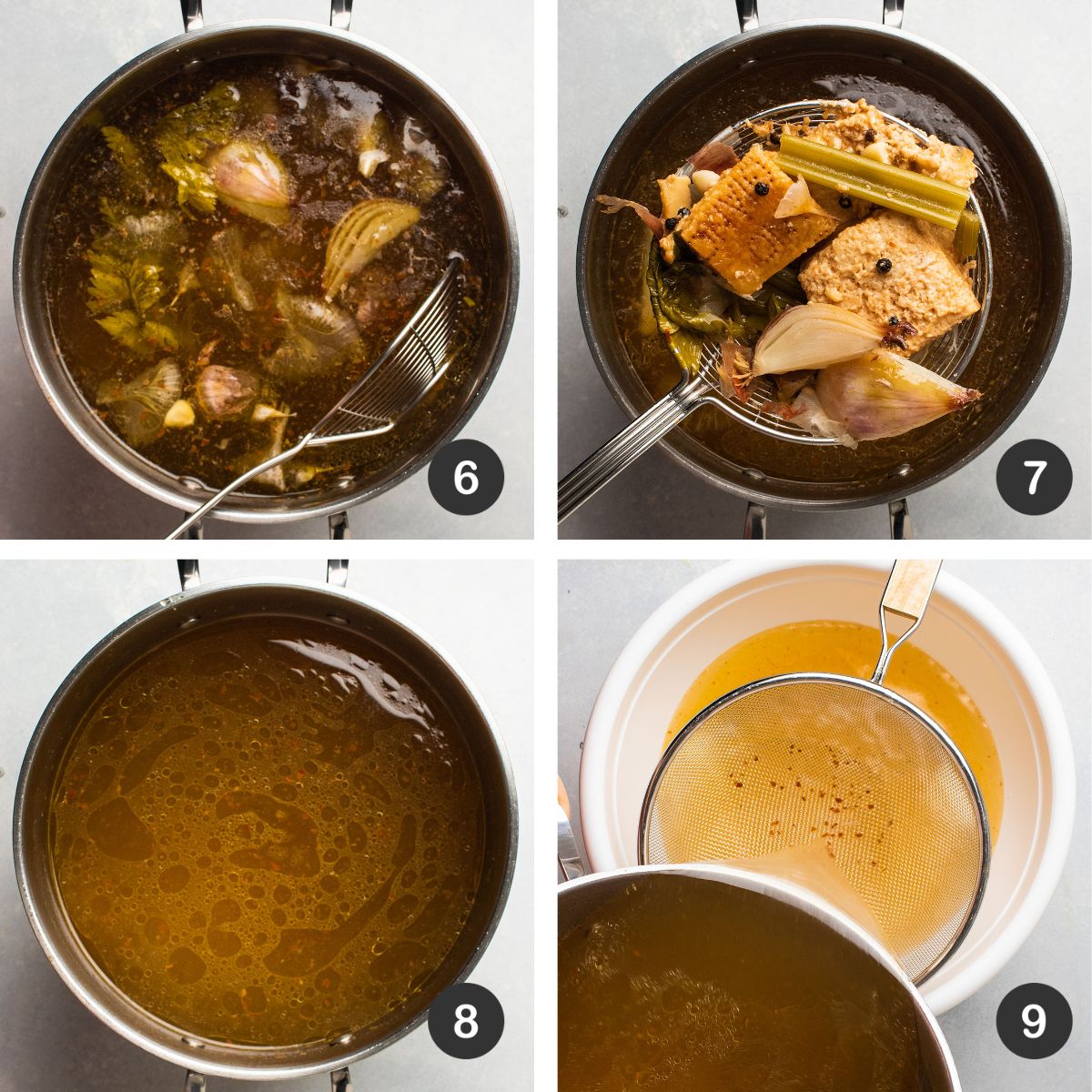
We like to start by using a large spider or slotted spoon to pull out the largest chunks from the stock (Images 6 and 7, above).
Once you've removed the big pieces, place a mesh strainer over a very large mixing bowl. Carefully pour the broth through the sieve and into the bowl (Image 9) to remove any last solid pieces (depending on the size of your bowl, you may need to do this in batches!)
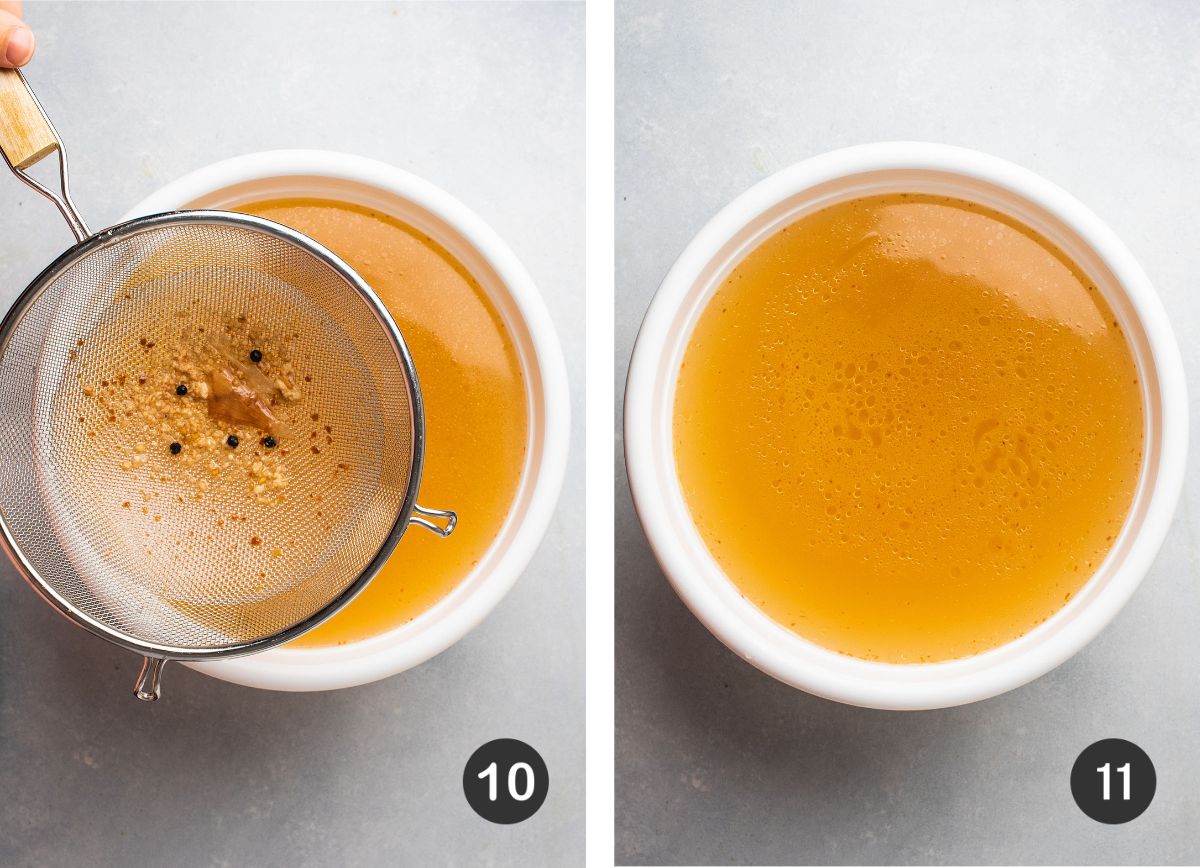
Compost or discard the solid pieces once they're strained out (Image 10). You'll be left with a big bowl of clear, golden parmesan broth (Image 11)!
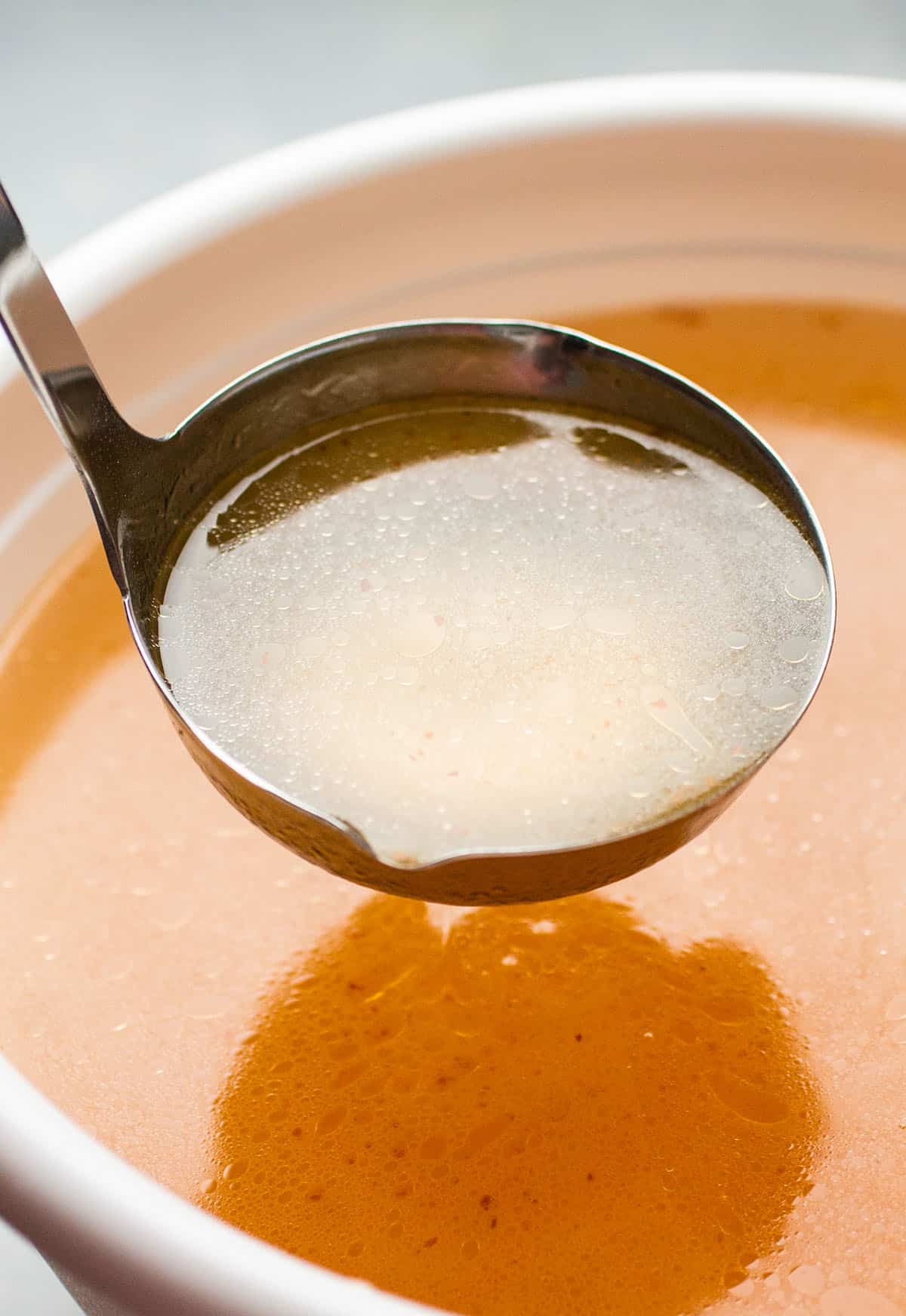
Let the broth cool on the countertop for an hour or so. Once it's cooled, you can start to pack it into containers for the fridge and freezer!
Storing and Freezing

Once your parmesan broth is completely cooled, use a ladle to transfer it to airtight containers. We like using plastic deli containers for our homemade stock: They're tall, sturdy, and will expand easily in the freezer without cracking.
Store parmesan broth in the fridge for up to a week, or freeze it for up to 6 months. Defrost frozen broth overnight in the fridge when you're ready to use it.
Three tips for Freezing Parmesan Broth
- Leave room at the top of the container. Broth will expand as it freezes: Be sure to leave at least an inch of room at the top of any jar or Tupperware, so the broth can expand without putting too much pressure on its container and causing it to crack or break.
- Use flexible, plastic containers if you can. When broth expands in the freezer, it can crack glass mason jars. We use plastic deli containers to store all of our frozen broth and stock!
- Label it! Parmesan broth looks just like chicken broth or turkey stock in the freezer. Be sure to label it "Parm Broth" and include the date you made it so you know what's what when you grab it later!
What to do with Parmesan Broth
You can use parmesan rind broth anywhere you'd normally use chicken stock, veggie stock, or turkey stock. Some of our favorite places to use it:
- As the base for Brothy Weeknight Butter Beans (it's also great in our pesto beans!)
- Add a scoop of parmesan broth to homemade spaghetti sauce, pizza sauce or white sauce for an extra layer of flavor.
- Use it in a good, cheesy risotto recipe (try it in our summer risotto, butternut squash risotto, or red wine mushroom risotto!)
- Build a quick, light pasta sauce with a scoop of parmesan stock, a squeeze of lemon juice, and a splash of heavy cream or butter.
- Swap it for chicken stock in your favorite light, brothy soup recipes. (It's excellent in minestrone, roasted tomato soup, or this sausage kale tortellini soup!)

A few FAQs
Unfortunately, no. The parmesan rinds are an essential component to this broth. If you leave them out, you'll just have a very light vegetable stock. If you'd like to make homemade broth without parmesan rinds, we recommend making a heartier vegetable stock, a homemade chicken stock, or turkey stock.
Typically, stock includes bones - it's made with drippings and scraps from chicken, turkey, or beef. Stock also tends to have a longer cook time in order to pull all of the nutrients and collagen out of those bones, and can therefore have a thick, gelatinous texture once it's cooled. Broth, by contrast, is cooked a little bit quicker. Broth may include meat, but won't necessarily include bones. Because this particular recipe uses no bones, it's easiest to classify it as a "broth." But honestly, they're pretty interchangeable. (Bone broth, for example, is technically a stock. So basically: Call this whatever you want.) Learn more: What's the difference between stock and broth?
It's really up to you! I typically leave my parmesan broth uncovered while it cooks because I love the way it fills the house with its aroma. Because this broth cooks pretty quickly, you won't lose too much liquid to evaporation - plus, letting that little bit of the liquid evaporate as the broth cooks helps to concentrate the flavor for a richer final product! If you have kids running around, or if you're planning to let the broth simmer for a longer period of time, you can pop the lid on while it cooks.
Yes - sauté the veggies in a separate pan (or skip this step entirely!) and toss everything in a large crock pot for 6-8 hours on low heat.
We recommend using a large stockpot or a large Dutch oven for this recipe. Look for a sturdy, relatively tall pot that will hold at least 5-6 quarts of liquid.
Recipes That Use Parmesan Broth
Swap the chicken or veggie stock in any of these recipes for your homemade parmigiano reggiano broth!
Did you make this recipe? Leave a comment and star rating below to let us know how it turned out!
Print📖 Recipe

Homemade Parmesan Broth
- Prep Time: 15 minutes
- Inactive Time: 3 hours
- Cook Time: 4 hours
- Total Time: 4 hours 15 minutes
- Yield: Makes 4 quarts 1x
- Category: Sauce
- Cuisine: Italian Inspired
Description
This easy homemade parmesan broth is perfect for pastas, soups, risottos, and more!
Ingredients
- 2 Tablespoons olive oil
- 1 large shallot, roughly chopped
- 1 stalk celery, roughly chopped
- 1 head garlic, halved
- ½ cup dry white wine
- 5-8 parmesan cheese rinds (use real Parmigiano Reggiano cheese rinds for best results)
- ½ teaspoon red pepper flakes
- 1 Tablespoon whole black peppercorns
- 4-5 quarts water (enough to almost fill whatever pot you’re using)
- Kosher salt to taste
Instructions
Sauté the Veggies (5-10 minutes)
- Heat olive oil in a large stock pot over medium-high heat. Add shallot, celery, and garlic and sauté, stirring only occasionally, for 5-10 minutes until some deep, golden brown color has developed across the surface of the veggies.
- Add white wine to the pot to deglaze, making sure to scrape up any browned bits from the bottom of the pan.
Build the Flavor & Simmer the Broth (2-4 hours)
- Add parmesan rinds, red pepper flakes, and peppercorns to the stockpot. Add water until the pot is nearly full, then stir in a pinch of salt.
- Reduce heat to medium-low. Let the broth cook at a low simmer, uncovered, for 2-4 hours. Stir the broth every hour or so to prevent the parmesan rinds from sticking to the bottom of the pot. When the broth is ready, the veggies will be quite soft and have lost most of their color, while the broth itself will be a rich golden hue.
- Turn off the heat and let broth cool for 30 minutes to an hour before straining.
Strain and Store (1 hour)
- Use a large slotted spoon or spider strainer to pull any large veggies and parmesan rinds out of the stock. Compost or discard these remnants.
- Set a mesh strainer on top of a very large mixing bowl. Carefully pour the broth through the sieve to remove any lingering solid pieces.
- Let broth cool completely, then transfer to airtight containers (we like to use large deli containers). Store in the fridge for up to a week, or in the freezer for up to 6 months. Use parmesan broth in risotto, soups, sauces, or anywhere else you would usually use chicken or vegetable broth!
Notes
Additions and Substitutions. This broth is very flexible. The parmesan rinds and water are the star players here (along with a pinch of salt) but the rest of the ingredients - what we like to call our "flavor enhancers" - are easy to adjust! Carrots, onion, bay leaves, fresh parsley or thyme, mushrooms, and leeks are all wonderful in this broth. We recommend using 4-6 flavor enhancers any time you make parmesan broth for a balanced, robust flavor. This is also a great place to use any leftover veggie scraps, like carrot peels, dark green leek pieces, end pieces of an onion, or garlic trimmings from roasting a head of garlic. Be sure to read the full post above for more guidance on swaps and substitutions!
Do I have to sauté the veggies? No - if you're short on time, you can skip this step. You'll lose a little bit of depth and complexity, but the broth will still taste great!
Storage and freezing. Let parmesan broth cool completely, then transfer to airtight containers. Store in the fridge for up to a week or in the freezer for up to 6 months. Defrost frozen parmesan broth in the fridge overnight when you're ready to use it. If you plan to freeze your parmesan broth, we recommend using plastic airtight containers instead of glass (the broth will expand as it freezes, which can cause glass jars to crack).
As the broth sets, any extra cheese will solidify! Some parmesan cheese will naturally melt off the rinds and into the broth as it cooks. When the broth cools, this cheese rises to the surface and can form a thick, white crust along the top of the broth. You can remove this cheese if you like, but we typically leave it! It will melt right back into the broth when you heat it up in a soup or other recipe. The broth may also have some large white chunks of parmesan floating around after you defrost it: This is normal and the chunks will melt back into the sauce once it's re-heated.
Use parmesan broth anywhere you would use chicken or veggie stock! We love this broth in brothy butter beans, tortellini soup, as a light pasta sauce with a squeeze of lemon juice, in a cozy summer risotto, or in place of veggie broth in our Magic Cauliflower Cream sauce!
Nutrition
- Serving Size: 1 cup
- Calories: 67
- Sugar: 0.4 g
- Sodium: 284.5 mg
- Fat: 4.1 g
- Carbohydrates: 3 g
- Protein: 3.6 g
- Cholesterol: 6 mg
Keywords: broth, stock, soup








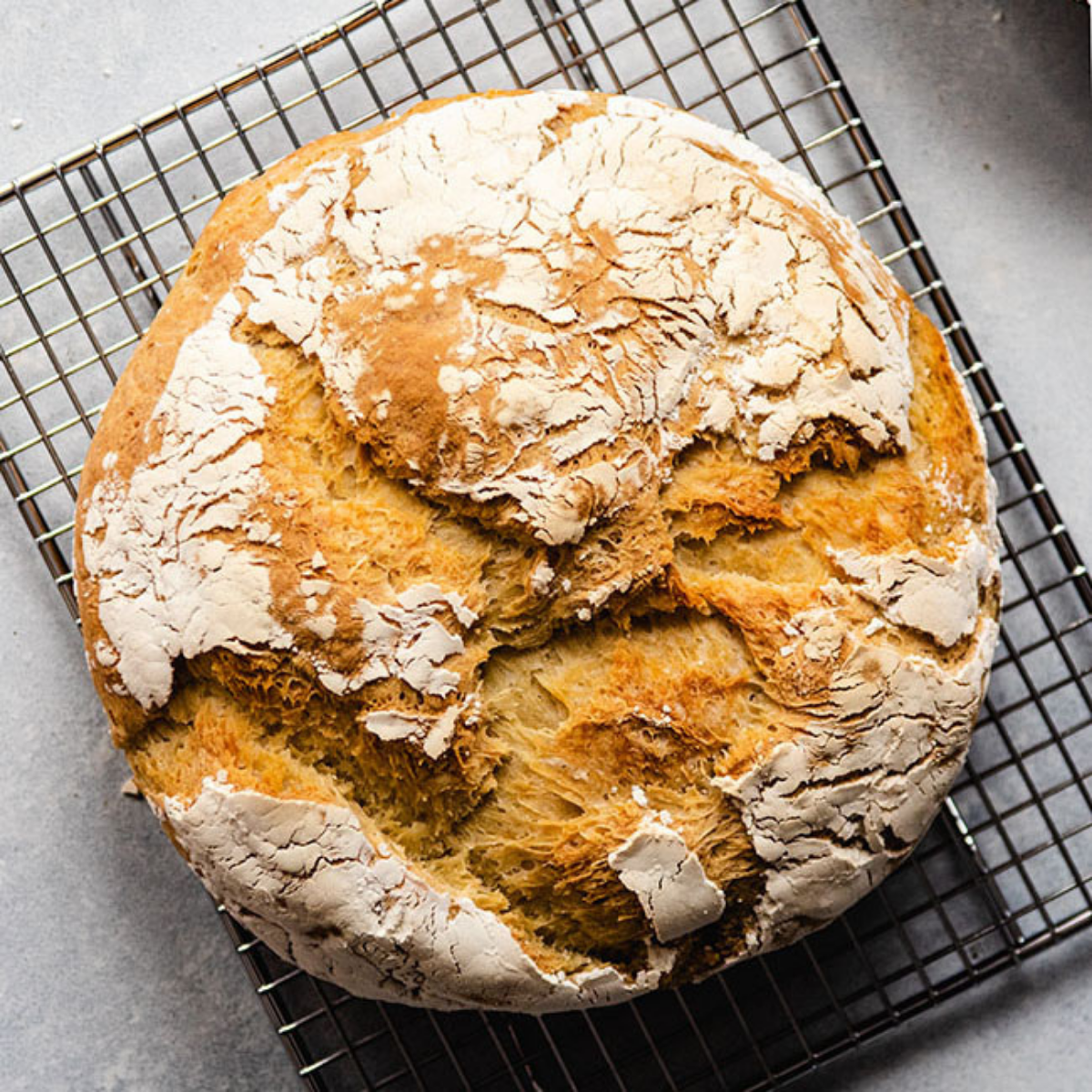




Jessie
I'm so excited to finally share this recipe with you! This parmesan broth is one of my most-made freezer staples: I put it in EVERYTHING.
★★★★★